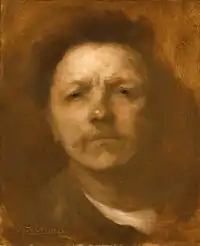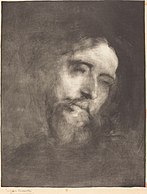Eugène Carrière
Eugène Anatole Carrière (16 January 1849 – 27 March 1906) was a French Symbolist artist of the Fin de siècle period. His paintings are best known for their brown monochrome palette. He was a close friend of the sculptor Rodin and his work influenced Picasso. Some see traces of Carrière's monochrome style in Picasso's Blue Period.
Eugène Carrière | |
|---|---|
 Self-portrait (c. 1893), oil on canvas Metropolitan Museum of Art | |
| Born | 16 January 1849 |
| Died | 27 March 1906 (aged 57) |
| Nationality | French |
| Known for | Painting, Lithography |
| Movement | Symbolism |
Biography
He was born at Gournay-sur-Marne (Seine-Saint-Denis). He studied at the École des Beaux-Arts in Paris and later under Cabanel. During the Franco-Prussian War he passed some time as a prisoner in Dresden, where the art of Rubens made a lasting impression on him, as may be seen in the glowing colors of his early paintings. About 1890 he adopted the gray, misty-color scheme with contrasts of light and shadow, so characteristic of his art, but which no other artist has been able to imitate without affectation.[1]
His themes usually are scenes of his domestic life, and he repeatedly introduced the likeness of his wife in his paintings. The first of these, The Young Mother (1879), is now in the Musée des Beaux-Arts de Rouen. It was followed by, The Sick Child (Montargis), The First Communion (Toulon), and the highly praised 1887 portrait of the sculptor Louis-Henri Devillez.[2]
Carrière was one of the leaders in the secessionist movement, which led to the founding of the Société Nationale des Beaux-Arts. At the Société, Carrière exhibited, among other works, Sleep (1890), the celebrated portrait of Paul Verlaine (1891, Luxembourg), Maternity (1892, Luxembourg), Christ on the Cross (1897), and Madame Menard-Dorian (1906).[1]
Carrière played an influential role as an art teacher at Académie de La Palette.
He also modeled a monument to Verlaine in the style of Rodin.
Several of his works may be found at the Musée d'Orsay in Paris and in National Museum of Serbia in Belgrade.
Selected paintings
 Priam at the Feet of Achilles (1876), oil on canvas, dimensions unknown, Musée des Beaux-Arts de Pau
Priam at the Feet of Achilles (1876), oil on canvas, dimensions unknown, Musée des Beaux-Arts de Pau_-_Winding_Wool_(Les_D%C3%A9videuses)_-_L692_-_National_Gallery.jpg.webp) Winding Wool (1887), oil on canvas, 99.5 x 87.6 cm., National Gallery, London
Winding Wool (1887), oil on canvas, 99.5 x 87.6 cm., National Gallery, London Woman from Behind Undressing (c. 1890-95), oil on canvas 46.5 x 38.5 cm., collection unknown
Woman from Behind Undressing (c. 1890-95), oil on canvas 46.5 x 38.5 cm., collection unknown%252C_oil_on_canvas%252C_220_x_490_cm.%252C_Mus%C3%A9e_Rodin%252C_Paris.jpg.webp) The Theater of Belleville (1895), oil on canvas, 220 x 490 cm., Musée Rodin, Paris
The Theater of Belleville (1895), oil on canvas, 220 x 490 cm., Musée Rodin, Paris Virgin at the Foot of the Cross (1897), oil on canvas, Strasbourg Museum of Modern Art
Virgin at the Foot of the Cross (1897), oil on canvas, Strasbourg Museum of Modern Art Le Réveil, Her Mother's Kiss (1899), oil on canvas, 94 x 120 cm., Pushkin Museum, Moscow
Le Réveil, Her Mother's Kiss (1899), oil on canvas, 94 x 120 cm., Pushkin Museum, Moscow The Mothers (1900). oil on canvas, 283.2 x 362.7 cm., Musée du Petit Palais, Paris
The Mothers (1900). oil on canvas, 283.2 x 362.7 cm., Musée du Petit Palais, Paris The Contemplator (1901), oil on canvas, 33.6 x 41 cm., Cleveland Museum of Art, Cleveland, Ohio
The Contemplator (1901), oil on canvas, 33.6 x 41 cm., Cleveland Museum of Art, Cleveland, Ohio Landscape in the Orne (c. 1901), oil on prepared paper mounted on canvas, 32.7 x 41.3 cm., Museum of Art, Rhode Island School of Design, Providence
Landscape in the Orne (c. 1901), oil on prepared paper mounted on canvas, 32.7 x 41.3 cm., Museum of Art, Rhode Island School of Design, Providence
Portraits and figures
 Portrait of a Boy (1886), oil on canvas, cm., Art Institute of Chicago
Portrait of a Boy (1886), oil on canvas, cm., Art Institute of Chicago%252C_oil_on_canvas%252C_149.8x_121.9_cm.%252C_Mus%C3%A9e_du_Louvre%252C_Paris.jpg.webp) Paul Verlaine (1890), oil on canvas, 149.8x 121.9 cm., Musée du Louvre, Paris
Paul Verlaine (1890), oil on canvas, 149.8x 121.9 cm., Musée du Louvre, Paris Portrait of Paul Gauguin (1891), oil on canvas, Yale University Art Gallery, New Haven
Portrait of Paul Gauguin (1891), oil on canvas, Yale University Art Gallery, New Haven Woman Leaning on a Table (1893), oil on canvas, 65 x 54.3 cm., The Hermitage, Saint Petersburg
Woman Leaning on a Table (1893), oil on canvas, 65 x 54.3 cm., The Hermitage, Saint Petersburg Woman Looking (date unknown), oil on canvas, 81 x 65,3 cm., Museo Nacional de Bellas Artes, Buenos Aires
Woman Looking (date unknown), oil on canvas, 81 x 65,3 cm., Museo Nacional de Bellas Artes, Buenos Aires Two Women (c. 1895), oil on canvas, Minneapolis Institute of Art, Minneapolis
Two Women (c. 1895), oil on canvas, Minneapolis Institute of Art, Minneapolis Girl with Her Hair Down (1900-05), dimensions unknown, Thiel Gallery, Stockholm
Girl with Her Hair Down (1900-05), dimensions unknown, Thiel Gallery, Stockholm Arsène Carriere (1899-1900), oil on canvas, 55.56 × 46.36 cm., National Gallery of Art, Washington, D.C.
Arsène Carriere (1899-1900), oil on canvas, 55.56 × 46.36 cm., National Gallery of Art, Washington, D.C.
Prints and graphics
 Newborn in a Bonnet (1890), lithograph, 25.5 x 19.2 cm., Cleveland Museum of Art
Newborn in a Bonnet (1890), lithograph, 25.5 x 19.2 cm., Cleveland Museum of Art Alphonse Daudet (1893), lithograph, National Gallery of Art, Washington, D.C.
Alphonse Daudet (1893), lithograph, National Gallery of Art, Washington, D.C. Henri Rochefort (1896), lithograph, British Museum, London
Henri Rochefort (1896), lithograph, British Museum, London Paul Verlaine (1896), lithograph, 52 x 40.6 cm., Cleveland Museum of Art
Paul Verlaine (1896), lithograph, 52 x 40.6 cm., Cleveland Museum of Art Puvis de Chavannes (1897), lithograph, National Gallery of Art, Washington, D.C.
Puvis de Chavannes (1897), lithograph, National Gallery of Art, Washington, D.C. Rodin (1897), lithograph, National Gallery of Art, Washington, D.C.
Rodin (1897), lithograph, National Gallery of Art, Washington, D.C. Sleep (1897), lithograph, National Gallery of Art, Washington, D.C.
Sleep (1897), lithograph, National Gallery of Art, Washington, D.C. Jean Dolent (1898), lithograph, 22.9 x 17 cm., British Museum, London
Jean Dolent (1898), lithograph, 22.9 x 17 cm., British Museum, London Mlle Marguerite Carrière Singing (1901), litograph, Thiel Gallery, Stockholm
Mlle Marguerite Carrière Singing (1901), litograph, Thiel Gallery, Stockholm Poster: Literary, Artistic, Aocial Aurore (1898), Bibliothèque Nationale de France
Poster: Literary, Artistic, Aocial Aurore (1898), Bibliothèque Nationale de France
See also
References
- Bantens, Robert (1989). Eugene Carriere: The Symbol of Creation. New York: Kent Fine Art.
- Louis-Henri Devillez in his Studio, by Eugène Carrière, 1887, tumblr.com
Further reading
- Séailles, Gabriel (1901). Eugéne Carrière, l'homme et l'artiste: Compositions et croquis de E. Carriére gravés par Mathie. Paris: Pelletan.
- Geffroy, Gustave (1901). L'oeuvre de E. Carrière (The Works of E. Carrière). Paris: H. Piazza.
- Morice, Charles (1906). Eugéne Carrière: L'homme et sa pensée; l'artiste et son œuvre; essai de nomenclature des oeuvres principales. Paris: Société du Mercure de France.
- Faure, Elie (1908). Eugéne Carrière, peintre et lithographe. Paris: H. Floury.
- Musée d'Orsay; Kokuritsu Seiyo Bijutsukan (National Museum of Western Art) (2006). Auguste Rodin; Eugène Carrière. Paris: Flammarion. ISBN 978-2-08-011626-0.
- Agnès, Lauvinerie; Eduardo Leal de la Gala (2006). Moi, Eugène Carrière. Paris.
External links
| Wikimedia Commons has media related to Eugène Carrière. |
- Eugène Carrière at the Museum of Modern Art
- Eugène Carrière: Symbols of Creations Exhibition at Kent Fine Art, New York
- Musée Virtuel Eugène Carrière
- Hollis, Richard. "Ghostly realist", The Guardian, August 26, 2006
- Paintings at Beauty and Ruin
- Paintings at Artcyclopedia
- Eugène Carrière at Hill-Stead Museum, Farmington, Connecticut
